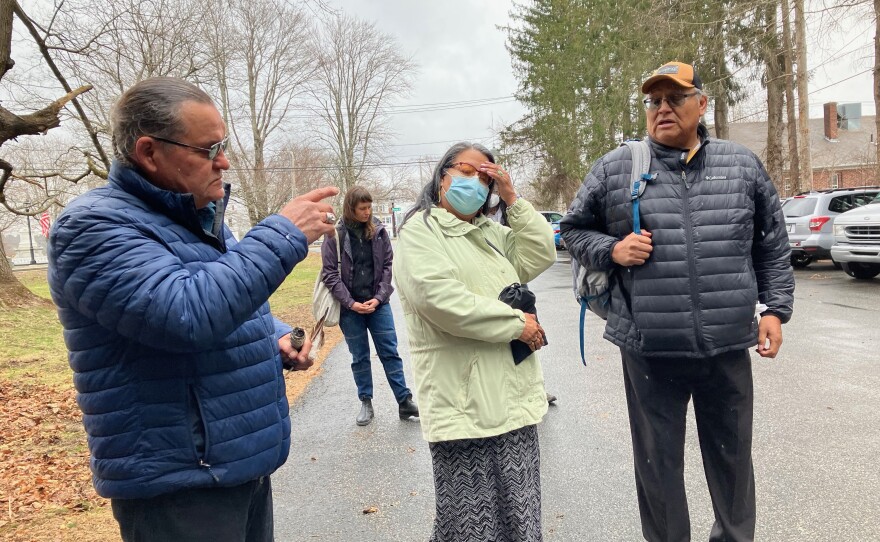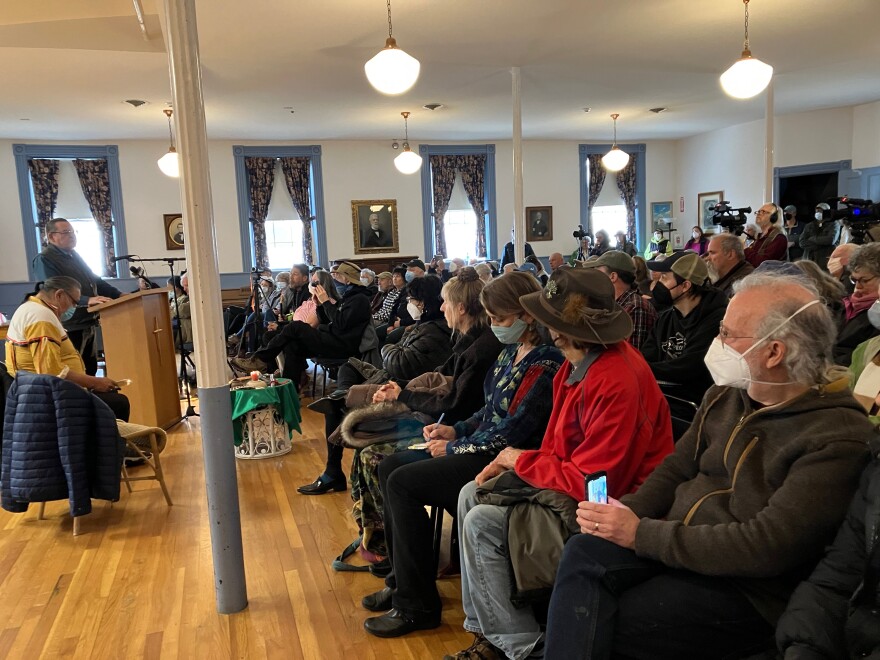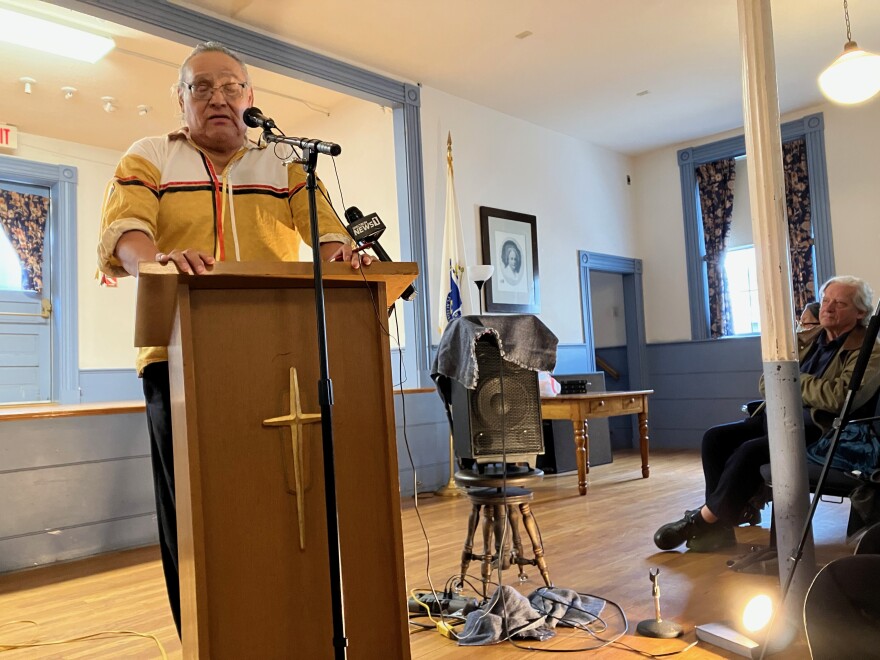After visit from Sioux leaders, Barre Museum says it will evaluate collection for repatriation

Chief Henry Red Cloud and Renee and Manny Iron Hawk gathered outside the Barre Museum Association before going in to view items they believe were taken off Native people killed at Wounded Knee in 1890. (Nancy Eve Cohen/NEPM)
The Barre, Massachusetts, Museum Association this week voted to start the process to return objects that once belonged to indigenous people. The vote comes a few days after native leaders from South Dakota visited the museum to lay claim to their ancestors’ belongings.
Renee and Manny Iron Hawk, from the Cheyenne River Sioux Tribe, and Chief Henry Red Cloud, who represents the Oglala Lakota, part of the Sioux nation, stood outside the public library which houses the tiny Barre Museum. Before going in, they burned sage to “smudge,” a ritual to purify themselves out of respect for the ancestors whose items they’re about to see.
“I share this smudge with everybody, all the light-skinned people that are here,” Red Cloud said.
Red Cloud believes items in the museum were taken off the bodies of native people who were killed by white soldiers in Wounded Knee, South Dakota, on December 29, 1890. Hundreds were massacred, including Manny Iron Hawk’s grandfather, Ghost Horse.
Iron Hawk said their ancestors are with them.
“I do believe they’re here today, waiting for their items to return,” he said. “I am glad, today, very happy. And I’m also sad spiritually, but these things are coming to the right way now.”
Native people have come here since at least the early 1990s trying to get things back.

The Barre Museum Association is located in the same building as the public library in Barre, Massachusetts. (Nancy Eve Cohen/NEPM)
The museum has more than 200 items, not all native, in dimly lit glass cabinets. Some may have been treated with arsenic for preservation, so handling them is complicated.
Before the pandemic, the museum was open six times a year.
Ann Meilus, president of the Barre Museum Association, said the objects were donated to the museum in the late 1800s by resident Frank Root.
“Root was a showman,” Meilus said. “He played up the Wounded Knee massacre, unfortunately, as his shtick to get people to come and view the Native American artifacts.”
Meilus said there is documentation showing a lot of the items were sold to tourists by Lakota people, and she said some items were mislabeled to engage the imaginations of visitors.
“I highly doubt if they really are off the bodies of the people at Wounded Knee. But that nevertheless does not curb the awful tragedy that happened at Wounded Knee. We would like resolution to this,” Meilus said. “I’ve been dealing with this for over 20 years.”
Meilus said the museum has had contact with different native people about the items for decades. She said she wants to make sure the museum is dealing with the legal tribal council.
But a resolution is in the works.

A crowd of supporters listened to Chief Henry Red Cloud of the Oglala Lakota in South Dakota. He came to Massachusetts in April 2022 to ask the Barre Museum Association to return his ancestors’ items. (Nancy Eve Cohen/NEPM)
“I shake your hand with a warm heart. Greetings to you,” Chief Red Cloud said after visiting the museum, addressing a crowd of supporters inside a nearby church. “It’s an honor for me to be here. To being able to view the collection across the street. But better yet, going to be able to take the items home.”
Red Cloud said in the early 1990s his cousins, uncle and aunts also visited Barre, trying to get things back. He said a lock of human hair, part of a scalp, was returned later that decade. He said when someone dies, a spirit-releasing ceremony has to take place.
“And that didn’t happen for the ancestors across the street over here,” Red Cloud said. “So they’re stuck in this limbo. They’re stuck here. So we’re going to make a way. The items are going to be be going home. But it’s going to take some time.”
Manny Iron Hawk also stood before the crowd, holding up a photograph of his grandmother.
“My grandma here, she survived the Wounded Knee massacre at the age of ten,” he said.
Iron Hawk told the story that was passed down from his grandmother, to his mother, to him. His grandmother always remembered how her grandmother took care of her during the massacre.
“As soon as the shooting starts, your grandma grabs you by the hand and runs to the nearest ravine. ‘Run, run, run! Because the cavalry is going to come after you. They’re going to hunt you down and kill you,’” he said.

Speaking in Barre, Massachusetts, Manny Iron Hawk tells the story of his grandmother, who survived the 1890 massacre at Wounded Knee, South Dakota. His grandfather was killed protecting his people. (Nancy Eve Cohen/NEPM)
Iron Hawk’s grandfather and his son were killed, protecting their people.
“So that’s the trauma that we have today, the Wounded Knee descendants. There’s a point we need to start healing and it began today,” Iron Hawk said. “Thank you.”
Red Cloud said he saw a number of items in the museum that he believes will be returned.
“A ghost dance shirt. I saw a saddle. I saw a headdress,” he said. “I saw moccasins of various sizes. I saw headgear, representing our tribe. I saw clothing that that our ancestors would have worn in that era.”
He said he also saw human hair, part of a scalp.
Meilus, the museum board president, doubts that. She said some of the items are decorated with horse hair. But the museum, which has only about $300, will apply for grants to hire a specialist to evaluate the entire collection.
“Anything that’s clearly spiritually associated with a tribe or used for funerary purposes or has human body parts — if there is anything left in the museum that has human body parts — that we would repatriate it to the proper tribe or attempt to identify the proper tribe,” she said.
Museum officials plan to follow a federal repatriation law, even though they are not bound by it, Meilus said, because the museum has not received federal funding.
Meilus said there is “a certain amount of sadness about potentially breaking up the collection.”
But, she said, “If anything brings the Lakota Sioux people closure for what happened at Wounded Knee — if we have to give up some stuff, if that gets them one step closer to closing, the trauma that they have suffered — I’m all for it.”
Renee Iron Hawk, the secretary of the Wounded Knee Descendants Association, said she supports following the repatriation law and having experts evaluate items. Still, she said, “I just don’t want all that paperwork, red tape to prevent us from receiving back our relative’s items.”
She said when someone dies in her culture, after a year they hold a ceremony.
“I would suggest that a ‘Wiping of the Tears’ occur with our relatives’ artifacts returned. And maybe we could do it here with you guys since they have been among you for so long,” she said. “Maybe you need to wipe your tears too.”
Red Cloud said it could be a year or more before items that belonged to those massacred at Wounded Knee are returned. But on this day, he said, his inner spirit was happy.
Then, he sang a unity song honoring the descendants and the people of Barre, encouraging the residents to remind the museum to return the items.
